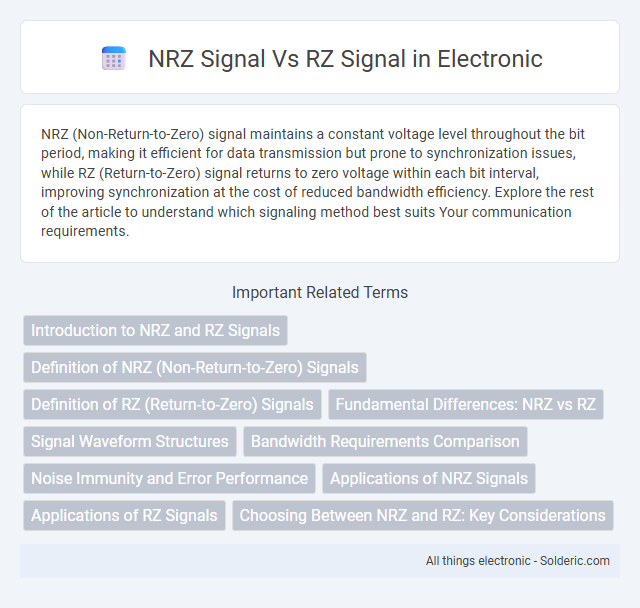NRZ (Non-Return-to-Zero) signal maintains a constant voltage level throughout the bit period, making it efficient for data transmission but prone to synchronization issues, while RZ (Return-to-Zero) signal returns to zero voltage within each bit interval, improving synchronization at the cost of reduced bandwidth efficiency. Explore the rest of the article to understand which signaling method best suits Your communication requirements.
Comparison Table
| Feature | NRZ Signal | RZ Signal |
|---|---|---|
| Definition | Non-Return-to-Zero encoding maintains signal level throughout the bit interval. | Return-to-Zero encoding returns signal to zero within the bit period. |
| Signal Level | Constant during bit duration. | Returns to zero halfway or at bit end. |
| Bandwidth Usage | Lower bandwidth requirement. | Higher bandwidth due to more transitions. |
| Synchronization | Poor synchronization; harder to detect bit boundaries. | Better synchronization due to mid-bit zero crossing. |
| Error Detection | Less error detection capability. | Improved error detection with signal return to zero. |
| Power Efficiency | More power-efficient, signal sustained. | Less power-efficient, signal drops to zero. |
| Use Cases | Used in basic digital communication systems. | Used in systems requiring easier clock recovery. |
Introduction to NRZ and RZ Signals
NRZ (Non-Return-to-Zero) and RZ (Return-to-Zero) signals are fundamental digital signal encoding schemes used in communication systems. NRZ signals maintain a constant voltage level throughout the bit interval, representing binary data without returning to zero between bits, which maximizes bandwidth efficiency but can cause synchronization challenges. RZ signals, in contrast, return to zero voltage level halfway through each bit interval, offering better timing synchronization at the expense of increased bandwidth usage, making your choice crucial depending on system requirements.
Definition of NRZ (Non-Return-to-Zero) Signals
NRZ (Non-Return-to-Zero) signals maintain a constant voltage level during each bit interval, representing binary data without returning to zero between bits, which enhances bandwidth efficiency in digital communication. Unlike RZ (Return-to-Zero) signals, which return to a baseline voltage within each bit period, NRZ signals reduce signal transitions, minimizing signal distortion and timing errors in transmission. Common NRZ formats include NRZ-L (level) and NRZ-I (inverted), widely used in serial communication and data storage applications.
Definition of RZ (Return-to-Zero) Signals
Return-to-Zero (RZ) signals are a form of digital signaling where the signal returns to zero voltage between each pulse, resulting in a clear distinction between logical ones and zeros. Unlike Non-Return-to-Zero (NRZ) signals, which maintain a constant voltage level during the entire bit interval, RZ signals have a pulse width shorter than the bit duration, allowing for easier synchronization and error detection. This characteristic improves timing accuracy but requires more bandwidth compared to NRZ signaling due to the increased signal transitions.
Fundamental Differences: NRZ vs RZ
NRZ (Non-Return-to-Zero) signals maintain a constant voltage level throughout the bit duration, representing binary values without returning to zero between bits, which allows for higher data rates and simpler hardware implementation. RZ (Return-to-Zero) signals, in contrast, return to zero voltage within each bit period, providing better synchronization and error detection at the cost of reduced spectral efficiency and bandwidth. The fundamental difference lies in the signal's voltage behavior during bit intervals: NRZ sustains the level, while RZ resets, impacting timing recovery and system complexity.
Signal Waveform Structures
NRZ (Non-Return-to-Zero) signal waveform maintains a constant voltage level throughout the bit interval, representing binary ones and zeros without returning to zero voltage between bits. RZ (Return-to-Zero) signal waveform, however, returns to zero voltage within each bit period, creating a midpoint rest that helps improve synchronization but reduces the duty cycle. The structural difference in waveform between NRZ and RZ significantly affects bandwidth requirements and error performance in digital communication systems.
Bandwidth Requirements Comparison
NRZ (Non-Return-to-Zero) signals require less bandwidth than RZ (Return-to-Zero) signals due to their constant voltage level over the entire bit duration, resulting in lower frequency components. RZ signals, which reset to zero within each bit period, generate higher frequency harmonics and thus demand approximately twice the bandwidth of NRZ signals. This increased bandwidth requirement in RZ can impact channel capacity and spectral efficiency in high-speed communication systems.
Noise Immunity and Error Performance
NRZ (Non-Return-to-Zero) signals exhibit lower noise immunity compared to RZ (Return-to-Zero) signals due to their continuous signal level, which makes them more prone to intersymbol interference and signal degradation in noisy environments. RZ signals, by returning to zero between bits, provide clearer timing information and reduce error rates through improved signal distinguishability and better synchronization. Consequently, RZ signaling often delivers superior error performance in high-noise communication channels despite its increased bandwidth requirements.
Applications of NRZ Signals
NRZ (Non-Return-to-Zero) signals are widely used in digital communication systems such as Ethernet, USB, and serial communication interfaces due to their efficient bandwidth utilization and straightforward implementation. They enable high-speed data transmission in fiber optic networks and satellite communications where signal integrity over long distances is critical. NRZ signaling is preferred in data storage devices like hard drives and solid-state drives for reliable, continuous bit stream representation.
Applications of RZ Signals
RZ (Return-to-Zero) signals are widely used in optical fiber communication systems due to their improved timing synchronization and reduced intersymbol interference compared to NRZ (Non-Return-to-Zero) signals. Applications include high-speed digital transmission, ultrafast optical networks, and data storage devices where signal integrity and error reduction are critical. RZ formats are preferred in environments requiring precise clock recovery and enhanced noise tolerance.
Choosing Between NRZ and RZ: Key Considerations
Choosing between NRZ (Non-Return-to-Zero) and RZ (Return-to-Zero) signals depends on factors like bandwidth efficiency, synchronization needs, and noise tolerance. NRZ signals offer higher bandwidth efficiency and simpler implementation but are more susceptible to baseline wander and timing errors. RZ signals provide better synchronization and noise immunity due to frequent signal transitions, making them suitable for long-distance communication despite requiring wider bandwidth.
NRZ signal vs RZ signal Infographic

 solderic.com
solderic.com